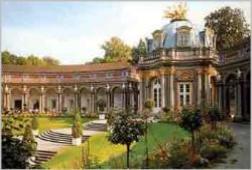
On April, 25th of 1945, without any forewarning, the area was bombed by Allied forces, 200 civilians were killed. The antique town center with many hospitals and the train station was nearly totally destroyed, however the military barracks didn’t suffer any damage.

Although Bayreuth had no military significance and posed no threat, because Bayreuth had been touted as an “Ideal German Town” and was a cultural landmark near and dear to German hearts, it was vindictively targeted for cultural bombing by the Allies at the very tail-end of World War Two. On April 5, 1945 almost half of the historic and lovely old city was successfully obliterated and about 1,000 civilians lay dead.
During the Reformation, Brandenburg embraced Lutheranism in 1539, and then expanded its lands to include the Duchy of Prussia in 1618 and the Duchy of Cleves in 1614 and elsewhere. It was too widespread to defend itself properly during the Thirty Years’ War, but after the devastation, its brilliant leaders, the first being the Great Elector Friedrich Wilhelm I, managed to take backwater Brandenburg to a pinnacle of power and prosperity in Europe.
The capital was moved from the town of Brandenburg to Potsdam and the electors became Kings of Prussia. The Margraviate of Brandenburg became the Province of Brandenburg in 1815. In 1881, Berlin was separated from the Province of Brandenburg. For most of recorded history, the founder of Berlin was considered to be Margrave Albert the Bear. The first authentic document concerning the city is from the year 1237 at the time of his great grandsons. From the year 1442 until World War One defeat, Berlin became the residence of the Hohenzollerns. By the early 20th century, Berlin was considered one of the most beautiful cities in the world.
The Palace Berlin before and after

|

|
The first bombs fell in June of 1940 on Bielefeld. In 1944, the heaviest air strike was launched on the city center on September 30 by 300 American bombers flying in 4 separate waves intentionally setting the city on fire with incendiaries and then issuing a final attack with time fuses ala the British.
600 civilians were killed and another 1,300 injured. 10,000 were left shelterless. More than 1,350 people in Bielefeld died from bombing by the end of the war, not accurately counting the numerous refugees from the east who had taken shelter in the city. 15,600 dwellings were damaged or destroyed, and then it experienced a flood of even more displaced refugees, raising the population from approximately 127,000 before the war to 155,000 in 1950. There was nothing much ancient or historical left in destroyed Bielefeld, and it was decided that the town would be rebuilt in the style modern at the time.
On March 14, 1945, the largest bomb which ever fell on a German city was dropped on the local Bielefeld railway viaduct, an important traffic facility which the Allies had unsuccessfully tried blowing up many times. England had to specially convert a Lancaster bomber for the bomb. “Dam buster” bombers were specially modified to carry the ‘Grand Slam’ 22,000lb (9,979kg) monster. At almost 10 tons, the Lancaster could only carry one bomb at a time. The pilot dropped the bomb about thirty metres from the viaduct and the resulting explosion caused powerful shock waves to radiate outwards destroying two arches each 1,100 feet in length. The bomb was the largest ever used in war, it could penetrate seven meters (23 feet) of reinforced concrete as it did on the U-boat pens near Bremen. The Grand Slam measured 7.7 meters in length and contained 4,144 kg of explosive. A total of 41 of these violent super-bombs were dropped during the war.

Bingen was destroyed eight times in history, and torn back and forth between possessors and occupying forces. A French municipal government was set up in Kreuznach after 1795, and after the defeat of Napoleon the town of Kreuznach came under Prussian control. After defeat in the First World War, the French again occupied Bad Kreuznach until 1930. Today, it is just another Rhineland town, most of it flattened by Allied bombing, with barely a pre-war building left standing from the RAF raids which left 80% of the outer city and 60% of the medieval inner city in ruins in 1944. Bingen’s old castle was all but destroyed, but has been rebuilt. Allied bombing in 1944 also took out the ceiling and collapsed part of the high altar of Bingen’s Basilica.
During one raid, 100 citizens had taken shelter in an old wine cellar when high explosive bombs caved it in and crushed them to death. Bad Kreuznach was badly damaged by a number of air raids during the final months of World War II. On Christmas day, 1944, 140 civilians died when 800 high explosive Allied bombs and mines plus 20,000 fire bombs were dropped on the town center. 4300 homes were destroyed and the population was halved. All bridges were blown up. 1,800 of the 3,500 dwellings and more than half of the trade and industrial plants were destroyed by the bomb attacks of 1941 followed by round the clock bomb raids at the end of the war. Americans took the town and they operated notorious prison camps nearby for German POWs. The Americans were replaced by French occupation troops in June and July. It no longer contained much of historical value.